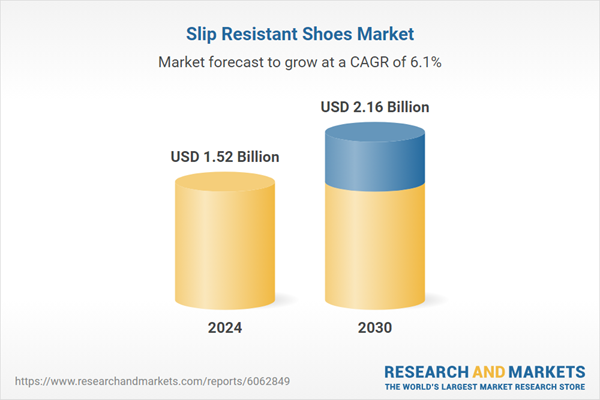Free Webex Call
The Slip Resistant Shoes Market was valued at USD 1.52 Billion in 2024, and is expected to reach USD 2.16 Billion by 2030, rising at a CAGR of 6.09%. This growth is underpinned by the increasing enforcement of workplace safety regulations and rising demand across sectors such as healthcare, hospitality, and manufacturing. As employers place greater emphasis on reducing workplace injuries, the adoption of slip-resistant footwear is accelerating. Speak directly to the analyst to clarify any post sales queries you may have.
10% Free customizationThis report comes with 10% free customization, enabling you to add data that meets your specific business needs.
Technological innovations in outsole materials - aimed at improving grip and durability - are further fueling market expansion. Heightened awareness surrounding occupational hazards and employee safety continues to drive product adoption. Meanwhile, the rise of e-commerce has enhanced accessibility to slip-resistant footwear, while advancements in customization and ergonomic design have strengthened consumer appeal.
Key Market Drivers
Stringent Workplace Safety Regulations
Global regulatory bodies have enforced rigorous workplace safety standards to mitigate occupational risks and safeguard employee well-being. Organizations such as the Occupational Safety and Health Administration (OSHA) in the United States and the European Agency for Safety and Health at Work (EU-OSHA) mandate the use of protective footwear in high-risk environments. Slip-resistant shoes are instrumental in preventing slip-and-fall incidents, which remain a leading cause of workplace injuries.Non-compliance with these safety standards can result in substantial financial penalties and legal consequences, prompting organizations to invest in high-quality, regulation-compliant footwear. As a result, these regulatory frameworks significantly contribute to market growth by driving demand for protective and compliant slip-resistant footwear solutions.
Key Market Challenges
High Product Costs and Affordability Constraints
One of the primary challenges hindering market growth is the high cost associated with premium-quality slip-resistant footwear. These shoes typically incorporate specialized rubber compounds, advanced tread patterns, and ergonomic features designed for enhanced comfort and longevity. Additionally, significant investments in research and development - particularly in improving traction performance, lightweight construction, and sustainability - further inflate production costs.Consequently, high-end slip-resistant shoes are often priced beyond the reach of small enterprises and price-sensitive consumers. This is especially true in developing regions, where businesses may opt for lower-cost alternatives that fail to meet safety requirements. The affordability gap hampers broader market adoption, particularly among organizations operating with limited budgets.
To overcome this barrier, manufacturers must prioritize cost-effective production strategies, including the use of alternative materials and streamlined manufacturing processes, to deliver high-quality footwear at more accessible price points.
Key Market Trends
Rising Demand for Sustainable and Eco-Friendly Materials
Sustainability has emerged as a strategic priority across industries, including the footwear sector. Both consumers and enterprises are actively seeking environmentally responsible products that minimize ecological impact without compromising on performance. In response, manufacturers of slip-resistant shoes are incorporating eco-conscious materials such as recycled rubber, plant-based components, and biodegradable synthetics into their product lines.Additionally, many brands are adopting environmentally friendly production practices, including water-efficient processes and reduced chemical usage, to align with global sustainability objectives. Leading companies such as Skechers and Timberland are increasingly investing in renewable materials to produce safety footwear that meets regulatory standards while supporting environmental stewardship.
As regulatory scrutiny around sustainability intensifies and consumer preferences shift towards greener products, demand for eco-friendly slip-resistant shoes is expected to accelerate over the coming years.
Key Market Players
- Crocs Inc.
- Keen, Inc.
- Shoes For Crews, LLC
- Birkenstock Digital GmbH
- Clement Design USA Inc.
- FILA Luxembourg, S.a.r.l.
- Skechers USA, Inc.
- Levi Strauss & Co. (Docker Shoes)
- Caleres, Inc.
- Nanotech Ceramics Co., Ltd.
Report Scope:
In this report, the Global Slip Resistant Shoes Market has been segmented into the following categories, in addition to the industry trends which have also been detailed below:Slip Resistant Shoes Market, By Sole Type:
- Rubber
- Synthetic
Slip Resistant Shoes Market, By Material Type:
- Leather
- Synthetic
- Others
Slip Resistant Shoes Market, By Sales Channel:
- Hypermarket/Supermarket
- Specialty Stores
- Online
- Others
Slip Resistant Shoes Market, By Region:
- North America
- United States
- Canada
- Mexico
- Europe
- France
- United Kingdom
- Italy
- Germany
- Spain
- Asia-Pacific
- China
- Japan
- India
- South Korea
- Indonesia
- South America
- Argentina
- Colombia
- Brazil
- Middle East & Africa
- South Africa
- Saudi Arabia
- UAE
- Turkey
Competitive Landscape
Company Profiles: Detailed analysis of the major companies present in the Global Slip Resistant Shoes Market.Available Customizations:
With the given market data, the publisher offers customizations according to a company's specific needs. The following customization options are available for the report.Company Information
- Detailed analysis and profiling of additional market players (up to five).
This product will be delivered within 1-3 business days.
Table of Contents
1. Introduction
2. Research Methodology
3. Executive Summary
4. Global Slip Resistant Shoes Market Outlook
5. North America Slip Resistant Shoes Market Outlook
6. Europe Slip Resistant Shoes Market Outlook
7. Asia-Pacific Slip Resistant Shoes Market Outlook
8. Middle East & Africa Slip Resistant Shoes Market Outlook
9. South America Slip Resistant Shoes Market Outlook
10. Market Dynamics
11. Market Trends & Developments
12. Porters Five Forces Analysis
13. Competitive Landscape
Companies Mentioned
- Crocs Inc.
- Keen, Inc.
- Shoes For Crews, LLC
- Birkenstock Digital GmbH
- Clement Design USA Inc.
- FILA Luxembourg, S.a.r.l.
- Skechers USA, Inc.
- Levi Strauss & Co. (Docker Shoes)
- Caleres, Inc.
- Nanotech Ceramics Co., Ltd.
Table Information
| Report Attribute | Details |
|---|---|
| No. of Pages | 181 |
| Published | April 2025 |
| Forecast Period | 2024 - 2030 |
| Estimated Market Value ( USD | $ 1.52 Billion |
| Forecasted Market Value ( USD | $ 2.16 Billion |
| Compound Annual Growth Rate | 6.0% |
| Regions Covered | Global |
| No. of Companies Mentioned | 10 |









